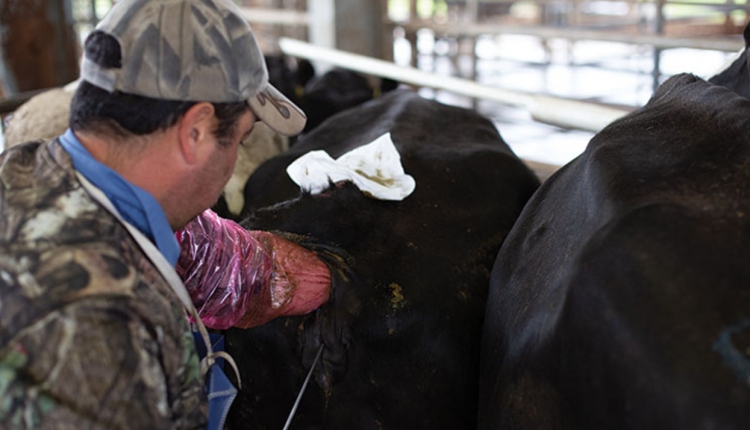The author is a professor of animal sciences and industry at Kansas State University, Manhattan.
The history of preserving bovine semen goes back more than 75 years. If you are past retirement age, you’ll remember semen being packaged in 1 cc glass ampules.

- Comparable conception rates
- Comparable or better sperm survival in storage
- Comparable doses of sperm to achieve optimal fertility
- Reduced storage space
Plastic straws for packaging liquid semen were first introduced in Denmark in 1940. During the 1960s, Robert Cassou of France introduced a medium-sized, polyvinyl chloride straw with a diameter of 2.8 mm (0.11 inch) and volume of 1/2 cc that replaced a larger straw with a diameter of 4.2 mm (0.16 inch) and volume of 1/2 cc. In 1968, Cassou introduced the 1/4 cc straw that remains in use today. In the U.S., glass ampules were replaced by the French straw during the early 1970s.
In the 1970s, commercial A.I. organizations in Europe and Canada adopted the smaller-diameter 1/4 cc straw, whereas A.I. organizations in the U.S. and most countries in Latin America opted for use of the 1/2 cc straw. This technology divergence among countries was largely based on the perceived degree of variance in inseminator skills, training, and proficiency in each respective country.
In Europe and Canada, about 90 percent of all inseminations in the early 1970s were performed by highly skilled professional A.I. technicians employed by the A.I. centers. Post-thaw semen handling issues were of lesser concern than in the U.S., where the trend has been for greater use by herdsman inseminators, which by definition possess more varied levels of expertise.
Straw size advantages?
The 1/4 cc French straw has been thoroughly studied and compared with the 1/2 cc French straw for approximately 50 years. Comparing the relative merits of 1/4 and 1/2 cc straws reveal at least three obvious differences:
1. The 1/4 cc straw requires less extender to fill and less space to store, potentially reducing production, storage, and shipping costs.
2. The larger 1/2 cc straw is easier to handle, easier to read, and may or may not suffer less breakage during storage.
3. The 1/4 cc straw responds to temperature changes faster than the 1/2 cc straws (more subject to cold shock).
The fertility of cattle inseminated with frozen-thawed semen packaged in 1/4 or 1/2 cc straws also has been the subject of research for more than 40 years, often with conflicting results, conclusions, and interpretations.
Fertility studies
We examined the scientific literature (J. Dairy Sci. 92:4432–4438) and found that fertility of cattle inseminated with extended semen packaged in 1/4 cc straws assessed in 13 studies with more than 770,000 inseminations had a weighted advantage of 0.9 percent (0.7 percent unweighted advantage) improvement in conception rates compared with semen packaged in the 1/2 cc straw.
In two studies in which palpated conception rates were obtained, the weighted advantage of the 1/4 cc versus the 1/2 cc straw was 0.2 percent (0.4 percent unweighted advantage). We could not detect a significant difference in pregnancy outcome between straw sizes.
Using a second statistical technique (logistic regression), we examined 15 studies with over 780,000 inseminations. We observed a large variation among studies and tended to detect a small advantage (0.51 percent) in pregnancy outcome for the 1/4 cc straw.
A third technique (meta-analyses) applied to various models of all 15 studies indicated the average odds of having a greater pregnancy outcome with the 1/4 cc straw were either 3 or 4 percent greater. On the basis of these odds, the expected proportion of difference in pregnancy outcome translated into a difference of 0.74 percent.
These small differences in pregnancy outcomes do not provide compelling evidence that a transition from 1/2 to 1/4 cc straws in the U.S. is warranted. This is especially true given the added negative aspects of semen handling and the greater potential for technician by straw type interactions among herdsman inseminators.
Therefore, the only meaningful difference between 1/4 and 1/2 cc straws is the diameter. With the exception of sexed semen packaged universally in 1/4 cc straws, which must be processed at lower sperm cell dosages, conception rates achieved with 1/4 and 1/2 cc straws are, for all intents and purposes, identical, provided inseminators pay strict attention to the details of proper semen handling.
Follow the directions provided by your A.I. supplier for proper thawing of semen. Research has demonstrated that rapid thawing of straws at 95°F (35°C) for a minimum of 45 seconds is the best method to maximize the post-thaw number of viable motile sperm.
Properly loading 1/4 or 1/2 cc insemination guns are similar. One can use a universal A.I. gun that accommodates both straw types or purchase separate guns that accommodate either 1/4 or 1/2 cc straws.
Universal guns typically work fine when you first purchase them. Later, however, alignment problems between the straw and plunger often develop due to a bent plunger or perhaps some debris or a burr inside the barrel.
When this occurs, use the following procedures:
After warming the gun, push the plunger all the way in so that the tip of the plunger is exposed on the straw end of the gun.
Remove the straw from the water bath and completely dry it with a clean paper towel.
Do not cut the lab seal end of the straw at this time.
Seat the cotton plug end of the straw onto the plunger and push the straw into the gun gently, causing the plunger to retract.
Cut off 1/4 inch squarely from the lab seal end of the straw.
Place the sheath over the end of the straw and A.I. gun and assemble as normal, taking care not to accidently push the plunger in the process.
Pluses and minuses
Although separate A.I. guns for 1/4 and 1/2 cc straws have obvious disadvantages, A.I. guns specifically designed for 1/4 cc straws have fewer alignment problems than do universal A.I. guns. In general, A.I. guns specifically designed for 1/4 cc straws will usually eliminate the need to seat the straw on the plunger and allow for loading procedures identical to those used for 1/2 cc straws.
Review procedures for thawing and handling semen to ensure you are not doing something that could compromise the potential fertility of each insemination. Happy A.I. breeding!










